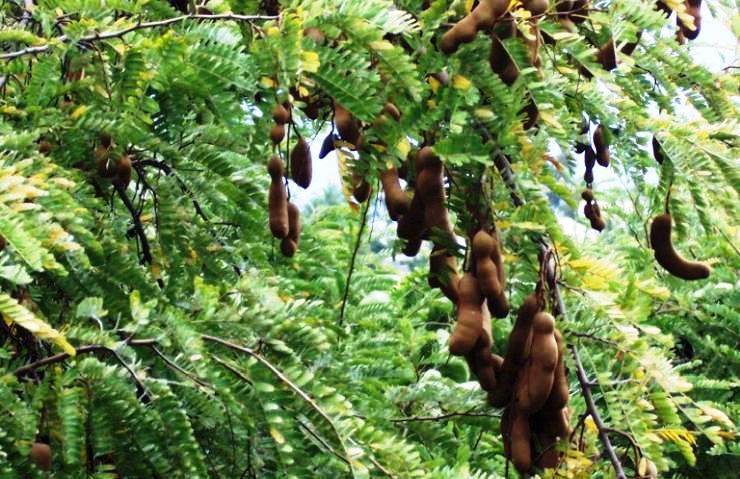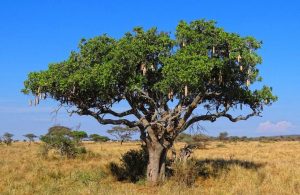The tamarind grows wild in semi-arid regions of Africa. It is used for various medicinal, culinary, food and ornamental purposes.
This plant is indigenous to tropical Africa but has become naturalized in North and South America, and is also cultivated in subtropical China, India, Pakistan, Indochina, Philippines, Java and Spain. The plant is mainly propagated utilizing seeds.
Different communities across Africa have different names for this unique plant. For instance, in Uganda, the tree is variously known as ‘Chwa’ among the Acholi tribe, ‘Enkooge‘ among the Baganda tribe and ‘Apeduru‘ among the Iteso tribe. In Benin, among the Peul ethnic group, the plant is known as ‘Djatani‘. In Mali, the Dogon ethnic group refers to it as ‘Somé‘ while in Senegal, the Wolof ethnic group refers to the plant as ‘Dahar’ while in Kenya the plant is referred to as ‘Mkwaju‘ in the Kiswahili language.
Every part of the Tamarindus indica plant including roots, stems, fruits, and leaves not only has rich nutritional values but also has broad usage in traditional medicine. The ripened fruit pulps are sweet and sour in taste and are used for various medicinal, culinary, food and ornamental purposes.
Among the many woody plants of economic importance commonly used in semi-arid lands, Tamarindus indica is one of the multipurpose tree species used daily by locals for food, medicine and culture. Its wood is hard and durable and its leaves and bark have numerous applications in traditional medicine and can improve one’s overall health if consumed regularly. The main attractions to this wonder plant lies to a greater extent in its fruit production. Initially, the fruit shows a reddish-brown colour that turns black-brown, becoming more aromatic and sourer on ripening.
In African traditional medicine, many communities use Tamarindus indica to make different popular decoctions for health purposes especially as an appetizer, laxative, anthelminthic, for the treatment of stomach disorders, general body pain, jaundice, febrifuge (for fighting fever), blood tonic and skin cleanser. It is also used to treat bronchial disorders. Gargling with tamarind water is recommended for a sore throat.
In some cases, Tamarindus indica fruits are also consumed by women to enhance their sexual enjoyment. Many traditional healers also rely on this wonder plant to treat and manage wound healing, abdominal pain, diarrhoea, dysentery, parasitic infestation, malaria, cancer, peptic ulcer, asthma, cough, and nerve repair. It is also commonly used in many countries because of its laxative and aphrodisiac properties.
The tamarind fruit pulp is most often eaten directly or soaked in water and the extract is drunk or mixed with other foods like porridge. Many communities encourage drinking the extract from the fruit pulp to reduce the risk of heart attack and other heart-related diseases in humans.
The fruit juice is also administered to quench thirst and to improve bowel movement to get rid of constipation. It’s also given as an energizer and for weight loss in case one is obese. Some traditional healers use the fruit pulp as a poultice applied to foreheads to relieve fever. The fruit syrup can be mixed with sugar and used to ease skin-burning sensation. The pulp is also believed to improve appetite as well as the restoration of sensation in cases of paralysis.
The fruit pulp is used for seasoning, as a food component, and in juices. Its fruit is regarded as a digestive, carminative, laxative, expectorant, and blood tonic. In some African communities, Tamarindus indica pulp is used as a sweetener in sorghum and millet porridge. Traditional healers use the pounded paste mixture of fruit pulps, leaves, and flowers of Tamarindus indica to relieve pain by applying it over swollen and painful joints.
The fresh stem bark and fresh leaves of Tamarindus indica are used to make a decoction which is mixed with potash for the treatment of stomach disorder, general body pain, jaundice, yellow fever and as a blood tonic and skin cleanser. The Tamarindus indica plant together with Sterculia Africana is used for stopping diarrhoea and dysentery.
Small parts of the twigs of the latter and leaves of the former are boiled together, and a cupful of the decoction is administered orally after cooling. A root decoction is administered as a cure for coughs and fevers and also to treat menorrhagia. In cattle-raring communities in some parts of Africa, Tamarindus indica pulp and leaves are added to animal feeds to enhance milk production in livestock.
Apart from the medicinal properties of Tamarindus indica, its pulp is a key ingredient in flavouring meals and snacks. It is used in desserts, as a jam, blended into juices, or sweetened drinks, sorbets, ice creams and other snacks. The hard green pulp of a young fruit is considered by many to be too sour but is often used as a component of savoury dishes in several African communities. Tamarind wood has high density and durability and is used in making furniture and wood flooring it’s also widely cultivated as an ornamental tree in many homes and tourism sites.
In conclusion, the Tamarindus indica tree remains one of the most interesting and highly valued medicinal plants in a wide range of communities in Africa, particularly as a plant with huge potential disease-healing ingredients and with the aid of modern techniques, the population of Tamarindus indica can be significantly increased to meet the ever-growing demand for it. (Komakech Richard – Photo: CC BY 2.5/ B.navez)







